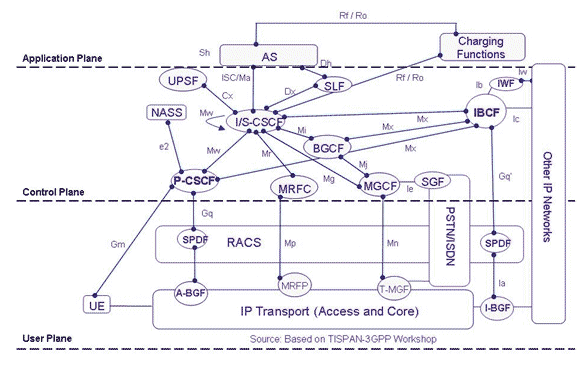The IP-Multimedia Subsystem (IMS) defines the functional architecture for a managed IP-based network. It aims to provide a means for carriers to create an open, standards-based network that delivers integrated multimedia services to increase revenue, while
also reducing network CapEx and OpEx.
IMS was originally designed for third-generation mobile phones, but it has already been extended to handle access from WiFi networks, and is continuing to be extended into an access-independent platform for service delivery, including broadband fixed-line
access. It promises to provide seamless roaming between mobile, public WiFi and private networks for a wide range of services and devices.
The IMS architecture has been designed to enable operators to provide a wide range of real-time, packet-based services and to track their use in a way that allows both traditional time-based charging as well as packet and service-based charging. It has become
increasingly popular both with wireline and wireless service providers as it is designed to increase carrier revenues, deliver integrated multimedia services, and create an open, standards-based network.
IMS provides a wide range of session border control, including call access control, reachability and security. It also provides a framework for the deployment of both basic calling services and enhanced services, including
- multimedia messaging
- web integration
- presence-based services
- push-to-talk.
At the same time, it draws on the traditional telecommunications experience of
- guaranteed QoS
- flexible charging mechanisms (time-based, call-collect, premium rates)
- lawful intercept legislation compliance.
Network operators also hope that IMS will cut their CapEx and OpEx through the use of a converged IP backbone and the open IMS architecture.
- The IMS architecture defines many common components (for example, call control and configuration storage) so less development work is required to create a new service as this existing infrastructure can be reused.
- The use of standardized interfaces should increase competition between suppliers; preventing operators from being locked into a single supplier's proprietary interfaces.
As a result, IMS should enable new services to be rolled out more quickly and cheaply, compared with the traditional monolithic design of telephony services.
IMS Architecture
The diagram below shows the IP Multimedia Subsystem architecture.

IMS decomposes the networking infrastructure into separate functions with standardized interfaces between them. Each interface is specified as a "reference point", which defines both the protocol over the interface and the functions between which it operates.
The standards do not mandate which functions should be co-located, as this depends on the scale of the application, and a single device may contain several functions.
The 3GPP architecture is split into three main planes or layers, each of which is described by a number of equivalent names: Service or Application Plane, Control or Signaling Plane, and User or Transport Plane.
Application Plane
The application plane provides an infrastructure for the provision and management of services, and defines standard interfaces to common functionality including
- configuration storage, identity management, user status (such as presence and location), which is held by the Home Subscriber Server (HSS)
- billing services, provided by a Charging Gateway Function (CGF)
- control of voice and video calls and messaging, provided by the control plane.
Control Plane
The control plane sits between the application and transport planes. It routes the call signaling, tells the transport plane what traffic to allow, and generates billing information for the use of the network.
At the core of this plane is the Call Session Control Function (CSCF), which comprises the following functions.
- The Proxy-CSCF (P-CSCF) is the first point of contact for users with the IMS. The P-CSCF is responsible for security of the messages between the network and the user and allocating resources for the media flows.
- The Interrogating-CSCF (I-CSCF) is the first point of contact from peered networks. The I-CSCF is responsible for querying the HSS to determine the S-CSCF for a user and may also hide the operator's topology from peer networks (Topology Hiding Inter-network
Gateway, or THIG).
- The Serving-CSCF (S-CSCF) is the central brain. The S-CSCF is responsible for processing registrations to record the location of each user, user authentication, and call processing (including routing of calls to applications). The operation of the S-CSCF
is controlled by policy stored in the HSS.
This distributed architecture provides an extremely flexible and scalable solution. For example, any of the CSCF functions can generate billing information for each operation.
The Control Plane also controls User Plane traffic through the Resource and Admission Control Subsystem (RACS). This consists of the Policy Decision Function (PDF), which implements local policy on resource usage, for example to prevent overload of particular
access links, and Access-RAC Function (A-RACF), which controls QoS within the access network.
User Plane
The User plane provides a core QoS-enabled IPv6 network with access from User Equipment (UE) over mobile, WiFi and broadband networks. This infrastructure is designed to provide a wide range of IP multimedia server-based and P2P services.
Access into the core network is through Border Gateways (GGSN/PDG/BAS). These enforce policy provided by the IMS core, controlling traffic flows between the access and core networks.
Within the User Plane
- the Interconnect Border Control Function (I-BCF) controls transport level security and tells the RACS what resources are required for a call
- the I-BGF, A-BGF Border Gateway Functions provide media relay for hiding endpoint addresses with managed pinholes to prevent bandwidth theft, and implement NAPT and NAT/Firewall traversal for media flo
分享到:









相关推荐
IMS核心网的架构及基本原理介绍,是中兴的培训资料,ppt做得挺好的。
IMS 基本概念 网络架构 移动公司培训教材
IMS核心网网络安全指标体系分析.pdf
与固定核心网络技术较成熟但投资相对乏力的现状相比,在移动通信市场强大的投资推动下,移动核心网络应该更有可能后来居上,在几年内快速打造成全国规模的下一代移动核心网络,实现网络架构NGN化,网络设备平台通用...
IMS核心网网络安全指标体系研究.pdf
IMS是新一代核心网架构,在NGN架构上实现,为实现多网合一而设计,本文作为IMS的基本介绍讲述其核心架构MGCF
IMS核心网网络安全指标体系研究 (1).pdf
移动通信网在经历了两代发展之后,目前3G标准已经成熟,并在一些国家...R99在无线接口引入了新的频率、新的无线技术,但在核心网络方面则保持了2.5G的GPRS引入后的网络架构,仅需升级支持3G的功能和2G、3G协同工作。
IMS中QoS架构,控制机制和服务模型的研究,孙涛,刘凯明,IP多媒体子系统(IMS)是实现网络融合和业务融合的核心标准,它能够提供多种形式的IP业务,符合通信网络融合的大趋势,将成为下一��
IMS即IP Multimedia Subsystem (IP多媒体子系统),是3GPP在R5版 本中提出的、对IP多媒体业务...IMS被认为是下一代网络的核心 技术,也是解决移动与固网融合,引入 语音、数据、视频三重融合等差异化业 务的重要方式。
在研究IMS网络架构的基础上,结合当前IMS的技术现状以及发展趋势,介绍了IMS的发展背景与核心技术,并针对电信运营商建设IMS网络的思路,从IMS的引入方式、IMS的网元建设方案、IMS与电路域的互通以及IMS业务平台的...
方案采用超文本传输呼叫会话控制功能设备(H-CSCF)提供Mw接口,接入IMS核心网,实现IPTV和IMS业务的融合组网。使得运营商无需对现有大量的IPTV终端进行升级和改造,就能在基于IMS的电信融合网络中提供IPTV业务;同时...
IMS软交换原理概述,IMS(IPMultimediaSubsystem)即IP多媒体子系统,由3GPP标准组织在R5版本基础上提出,是在基于IP的网络上提供多媒体业务的通用网络架构,R5版本主要定义了IMS的核心结构、网元功能、接口和流程等...
基于IMS的网络融合方案描绘了美好的网络发展前景,因此受到了运营商的广泛追捧。运营商们也希望通过这种方案实现在统一的核心网络上为固定和移动用户提供丰富的统一的业务体验,同时通过这种方案降低网络结构的...
3GPP定义的IMS框架协议,描述了IMS的整体架构、功能、接口,IMS各个网元如S-CSCF、P-CSCF等的功能,业务流程。以及IMS与3G、4G核心网业务流程中的信令交互。
IMS自在3GPP R5提出来,以其支持移动固定多种接入、开放灵活的业务架构,已经被欧洲固定标准组织TISPAN、国际电联ITU-T等接纳,成为核心网的唯一标准。 国外领先运营商FT、BT、DT、KPN、Verizon等均在2006-2007年...
IMS多媒体彩铃的信令流程图 多媒体彩铃系统包括终端、接入网、IMS核心网、提供多媒体彩铃业务的SIP应用服务器(AS)、存储多媒体资料的媒体服务器(MS)和数据库(DB)。 多媒体彩铃系统架构如图2所示。用户可以通过...
IP多媒体子系统)是3GPP在Release5版本提出的支持IP多媒体业务的子系统,它的核心特点是采用SIP协议和与接入的无关性,在网络融合的发展趋势下,3GPP、ETSI和ITU-T都在研究基于IMS的网络融合方案,实现固定网和移动...
IMS 核心网平台的软件实现现在基本以Open IMS Core 为主. 当今大部分IMS 客户端各有所长, 但互通 性较差. Doubango 的客户端元素在Doubango 统一框架下构建, 无线客户端和固网客户端具有同样的交换信息算 法并能...
传统电路交换机是一种集成的、封闭的系统结构,无法快速满足多样化的用户需求,无法快速...IMS的提出为下一代基于IP的移动网络提供了面向分组数据包交换的多媒体服务及平台,它的核心特点是基于SIP协议和接入的无关性。